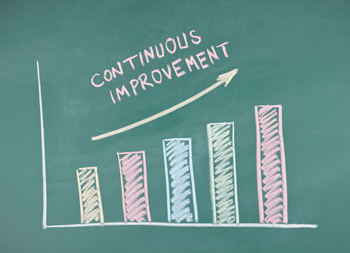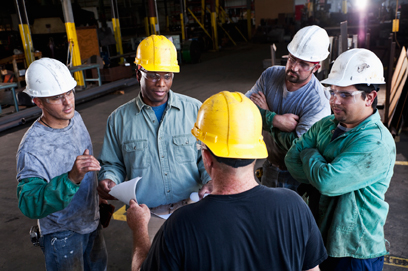Merging the Methods of Behavior-Based Safety and Continuous Improvement: A Case Study
The Toyota Production System (TPS) goes by many names and acronyms such as the Global Production System (GPS), Continuous Improvement (CI) and most recently Lean Sigma. All of these processes often suffer from a "not-invented-here syndrome," (meaning that no other performance improvement methods are considered or integrated), a syndrome that can quickly take the continuous out of improvement. Strategies such as lean manufacturing, one-piece flow, just in time and lean sigma can have a huge positive impact on a company's profitability, especially for industrial plant operations, except for the fact that many such operations have trouble sustaining those initiatives.
 For the past four years a large equipment manufacturing operation in Iowa has enjoyed benefits from Kaizen (the Japanese term and system for Continuous Improvement better known as the Toyota or Global Production System). Yet the operation has also experienced difficulty in maintaining the demands of the process. The question is why? This case study presents key information that could benefit future implementation teams working on behavioral management processes and/or continuous improvement programs.
For the past four years a large equipment manufacturing operation in Iowa has enjoyed benefits from Kaizen (the Japanese term and system for Continuous Improvement better known as the Toyota or Global Production System). Yet the operation has also experienced difficulty in maintaining the demands of the process. The question is why? This case study presents key information that could benefit future implementation teams working on behavioral management processes and/or continuous improvement programs.
The operation evaluated here is unusual in that its several manufacturing facilities are contiguously located on the same property. The company does business internationally as well as domestically and employs approximately 2000 people with very similar cultural backgrounds. The organization, which produces agricultural and construction-related equipment, began implementing Continuous Improvement (Kaizen) in 1998 and behavior-based safety (BBS) in the spring of 2001. Because of its contiguous layout and the close-to-identical similarity of each of its manufacturing plants, this facility offered a natural "petri dish" environment from which to monitor various effects in sustainment of Kaizen improvements compared to its plants that had not also implemented a behavior-based management system.
Early in 2001 one of the manufacturing facilities began implementation of a behavior-based safety approach designating specific safe behaviors, observing people on the job, providing feedback and rewarding and recognizing improvement. From the onset several managers and supervisors realized the behavior-based elements of the safety process could be used to enhance, complement and sustain the continuous improvement system. Behavior-based systems require flexibility to address the diverse behavior chains unique to a variety of performances. That may be the reason that behavior-based systems are better designed for integration with other ongoing improvement processes.
 When implementing break-through Kaizen methodologies, the company acknowledged that blending strategies of existing management styles to address quality, cost, delivery, safety and morale-related issues was important, but no one was exactly sure how to go about the task. In addition, people knew that sustainment of Kaizen methods would be a key to long lasting improvements and cost containment. Employee ownership and acceptance of Kaizen activities on a day-to-day basis by the people on the shop floor presents the greatest challenge for the company. All of the company's seven manufacturing operations use Kaizen to drive shop floor improvement. It seems reasonable that using behavioral methods such as pinpointing and measuring of behaviors followed by consequence management focusing on positive reinforcement will enhance the success and long-term sustainment of plant performance improvement processes.
When implementing break-through Kaizen methodologies, the company acknowledged that blending strategies of existing management styles to address quality, cost, delivery, safety and morale-related issues was important, but no one was exactly sure how to go about the task. In addition, people knew that sustainment of Kaizen methods would be a key to long lasting improvements and cost containment. Employee ownership and acceptance of Kaizen activities on a day-to-day basis by the people on the shop floor presents the greatest challenge for the company. All of the company's seven manufacturing operations use Kaizen to drive shop floor improvement. It seems reasonable that using behavioral methods such as pinpointing and measuring of behaviors followed by consequence management focusing on positive reinforcement will enhance the success and long-term sustainment of plant performance improvement processes.
In areas where Kaizen has been used, sustainment means the ability or desire to maintain the improvement achieved from a Kaizen improvement project known as an event. This includes fundamental things such as keeping the workplace organized and clean, establishing standard work instructions and maintenance schedules, measuring Takt time, cycle time and lead time on a daily basis, maintaining floor space reduction improvements, and so on. Sustainment is achieving all this and more without continual management prompting.
Following are some conclusions drawn from a recent employee insight survey. The survey compared employee answers to questions about their jobs and grouped responses based on their level of Kaizen experience:
- Positive feelings about employee involvement directly correlated to the number of Kaizen events employees had participated in. In fact the results showed it was statistically more significant as the number of events increased. Similar types of results were documented regarding employees' feelings toward supervision, career advancement opportunities, and job satisfaction. The same was true regarding their attitude toward the entire Kaizen initiative.
- Employees who participated in more Kaizen events felt their supervisor did a better job of communicating.
- Employees who participated in more Kaizen events felt they had better opportunities to share their views with the team.
- Employees who participated in more Kaizen events felt CI (Kaizen) was going to be a permanent part of the way the company operates.
- There were a significant number of employees who felt that after a Kaizen team finished it's work there was not adequate follow-up to make sure that recommended changes were maintained and implemented successfully
- Employees who participated in more Kaizen events felt that the Kaizen initiative improved the efficiency of operations.
- Employees who participated in more Kaizen events viewed the Kaizen initiative as necessary to ensure competitiveness.
- Only 50 to 60 percent of the employees felt they were receiving adequate feedback regarding customer satisfaction with the work they performed. There was a direct correlation between how positive employees felt and the number of Kaizen events they had participated in. The same was true about how positive they felt about the future.
- An overwhelming majority of all employees expressed a belief that the company is socially responsible in the community and to the environment.
- Employees who participated in more Kaizen events showed a statistically significant difference in positive response to how satisfied they were to be working at the company.
- A majority of the employees said the company was a good place to work and that they were proud to be associated with the company. Employees who participated in more Kaizen events felt more positive about these two areas than those who only had participated in zero to three Kaizen events.
- Employees who participated in more Kaizen events showed a significant difference in how positive they felt about whether their job offers opportunity to use their abilities.
- The majority of employees, regardless of their Kaizen experience, felt their job was really worthwhile and gave them a sense of personal accomplishment. They also viewed their jobs as important to the company.
 This information was collected by an independent survey firm hired by the company to obtain honest feedback regarding employee perceptions about their jobs, company policies, practices, programs, the work environment and supervision. Statistically significant differences were calculated at the 95 percent confidence level.
This information was collected by an independent survey firm hired by the company to obtain honest feedback regarding employee perceptions about their jobs, company policies, practices, programs, the work environment and supervision. Statistically significant differences were calculated at the 95 percent confidence level.
The bottom-line conclusion when analyzing the survey response data is that employees who have participated in more Kaizen events generally feel more positive about their jobs and about the company.
The big question that remains then is why is there a struggle on a daily basis to sustain continuous improvement activities following the Kaizen events)? It could be that the lack of adequate sustainment is neither the fault of management nor the employees. Instead a weakness exists in the implementation process. A lack of reinforcement and appropriate consequence management are missing mechanisms that when blended into the Continuous Improvement (Kaizen) process produce superior results.
For those who understand behavior from a scientific perspective, it’s clear to see that the Kaizen process at this manufacturing company doesn't have the necessary ongoing support required to maintain the high level of attention to detail that the process requires. A behavioral approach involves having the right consequences in place to support the new process and the time that’s required to integrate it into the culture of the organization. In other words, until it becomes a habit to perform a certain way while doing one's job, people easily revert back to the old way of doing things. Most continuous improvement systems don't include an ongoing feedback and support structure of consequence management. This company's Continuous Improvement program is missing these key elements. For example, managers are not instructed on how to behave to keep the system going. Consequently the success of Kaizen is left to chance and it’s quite likely any successes achieved will not be sustained. Continuous improvement processes need to build in a focus on behavior and the necessary consequences that will lead to sustainable change.
The Company's Kaizen Process
 The company uses a breakthrough Kaizen methodology to drive efficiency, standardized work, organization, and improvement by continually reevaluating processes and eliminating waste from those processes. A Kaizen Promotion Office (KPO) manager/facilitator spearheads these continuous improvement efforts. The KPO manager or some other member of management examines each operation and targets areas where the greatest opportunities for improvement exist -- the low hanging fruit, so to speak. Next one of these individuals writes a list of improvement objectives for a particular work area. For example, in the manufacture of a machine, the process from the time when the material comes through the door until it is assembled into a finished unit is analyzed. Or the analysis may go back even further to include lead time from the time the customer picks up the phone and places the order, all the way until the product is delivered to that customer's dock.
The company uses a breakthrough Kaizen methodology to drive efficiency, standardized work, organization, and improvement by continually reevaluating processes and eliminating waste from those processes. A Kaizen Promotion Office (KPO) manager/facilitator spearheads these continuous improvement efforts. The KPO manager or some other member of management examines each operation and targets areas where the greatest opportunities for improvement exist -- the low hanging fruit, so to speak. Next one of these individuals writes a list of improvement objectives for a particular work area. For example, in the manufacture of a machine, the process from the time when the material comes through the door until it is assembled into a finished unit is analyzed. Or the analysis may go back even further to include lead time from the time the customer picks up the phone and places the order, all the way until the product is delivered to that customer's dock.
Once the objectives are identified a five-day Kaizen event is scheduled. The main objective of the Kaizen event is to eliminate waste in the process in order to shorten the lead time for the customer to receive his/her order. The Kaizen event will do this by focusing on the reduction of what is called work in process cycle time. The Kaizen event identifies areas for reduction in cycle time, inventory and space reduction. Five S is practiced during the event and puts in place a system for employees in the work area to sort-sweep-simplify-standardize and SUSTAIN the improvements from the event. A good analogy to Five S is spring-cleaning and systematically organizing your garage, then keeping it that way. Of course, keeping it that way (or sustainment) is often the stickler.
In short, Kaizen is a methodology used to organize the workplace and drive discipline to eliminate waste in a process. A Kaizen event usually consists of five objectives. One of those objectives targets floor space reduction, another inventory or work-in-process reduction, another cycle time reduction. Cycle time is not to be confused with lead-time. Cycle time is the amount of time it takes from the minute one picks up a part to do a particular operation to the time that part is processed at the next operation. Cycle time includes wait time or the amount of time that the part just sits around. Safety is also an objective. The Kaizen team typically identifies one or two safety improvements every day during this five-objective, five-day event.
Each Kaizen team is usually made up of 8-10 people, typically with a third of those people from office, engineering or management areas, a third from the area where the work is being improved and a third coming from other operations across or within the facility. The theory behind the mix is that the various members might take some of the new techniques back to their work areas and that these "outsiders" may have fresh insights on the way things are done and offer suggestions on how to do a task more efficiently with less waste in the process. The first day of the Kaizen event focuses on training and days 2-3 focus on achieving the specified shop floor objectives. The event ends with a group presentation to senior management.
The Missing Link
The last part of the Kaizen event is a celebration with the senior management for a job well done. Because the Kaizen leader only gets involved with the process to the extent of coaching and counseling the team during the event there is no mechanism for continued reinforcement and behavioral management. The leader is somebody who has been through the process before and who understands how to drive the team towards meeting the objectives but the leader usually has no connection to the workers in the area after the event has ended.
 In contrast, the company's behavior-based safety system uses a coordinator who acts as a team leader from a work area. The coordinator is a member of a steering team made up of other coordinators and management representatives including the plant manager. Initially a good bit of effort goes into detailed training in the BBS process for 25 percent of the plant population and 100 percent of management. Employees who have been trained participate as observers and work with the coordinator and manager from their work areas in teams of people from each work area who have agreed to work together to help drive the safety process. The teams set goals, pinpoint safe behaviors to observe, plan celebrations and set new goals when behaviors by the employees in the work area reach habit strength.
In contrast, the company's behavior-based safety system uses a coordinator who acts as a team leader from a work area. The coordinator is a member of a steering team made up of other coordinators and management representatives including the plant manager. Initially a good bit of effort goes into detailed training in the BBS process for 25 percent of the plant population and 100 percent of management. Employees who have been trained participate as observers and work with the coordinator and manager from their work areas in teams of people from each work area who have agreed to work together to help drive the safety process. The teams set goals, pinpoint safe behaviors to observe, plan celebrations and set new goals when behaviors by the employees in the work area reach habit strength.
A crucial difference between the Kaizen and the behavior-based system is that the people from the work area own the process. They determine the behaviors they want to improve. In the Kaizen process, management determines the behaviors they want changed. In the behavior-based safety process the employees continue to run the process after the initial training. The behavioral safety facilitator will work with the plant over the course of a year to get 100 percent of the employees trained in the process. The facilitator helps the plant manager prepare for steering committee meetings and provides support on a continual basis. The employees run the process themselves and then bring feedback regarding their experiences back to central committee meetings. The Kaizen process is management driven. The behavior-based safety process is employee owned and employee driven. This key difference makes the BBS process easy to manage. Results are positive and sustainment is not an issue.
In Kaizen the targeted employee behaviors are expected to change overnight even though they are usually deeply ingrained work habits. With the BBS process, employees typically begin with something very simple like bringing the use of safety glasses or earplugs to habit strength. A very important thing however is happening during this first implementation. Employees are also learning how to communicate, how to reinforce others, and how to get comfortable talking to people about something as personal as their own safety.
Because work areas which have been through a Kaizen undergo a lot of changes overnight it only makes sense that the process needs to include a method of teaching employees how to master communication skills and how to reinforce other's behaviors to achieve a desired outcome. Employees working in work cells or on an assembly line depend upon both team members and non-team members to help them be successful. To maintain all the changes from a Kaizen event many behaviors must be modified. This extensive behavior change does not happen without appropriate reinforcement at the appropriate frequency. The Kaizen process this company uses does not include these critical behavioral elements and thus the respective work areas struggle with sustainment.
However, the work areas with the highest levels of sustainment across the company are those areas in which managers and workers are utilizing the skills they have learned from the BBS process! These supervisors are finding that as they grow comfortable with the BBS process the work groups are completing Kaizen changes faster and they sustain those changes. Workers are quick to discover that, when they perform safely or follow standard work and somebody comes by and says, "Good job" they like it. In the plant where the BBS process has been implemented, the reinforcement mechanism is developing, aided by the fact that management shows commitment by attending the meetings and giving the employees enough time to do safety observations. Managers are also reinforcing people on an ongoing basis by saying the right things at the right time and at the right frequency. With the BBS process going strong, the plan is to start training another 10 percent of the population with a soon-to-be-achieved goal of reaching critical mass in the use of behavior-based safety. Sure, the areas will progress at different paces, but the important thing is that the employees own the process and the process is sustained.
The employees can make most of these decisions and the necessary observations and corrective actions because they've been trained well and given the authority to do so. Over the long term, behavior-based safety will consequently become part of the company's culture. The behavior-based technology is already spilling over into quality areas and as noted above, into Kaizen sustainment. Because supervisors have discovered that BBS is easy to manage and can easily be used to drive other improvements using observation, pinpointing and reinforcement, they are promoting its use.
In all of the company's plants, management has begun using a new technique called Managing For Daily Improvement (MDI) to drive sustainment. The major difference between a behavior-based/performance management approach and the MDI approach is that now, employees with a BBS background, are more likely to take ownership of MDI, drive it and manage it. MDI is a great process but it requires consistent management, by management, to be effective and survive. On the other hand, BBS requires support, resources and time, but without management the process would continue to sustain. It will be interesting to see if Kaizen sustainment improves in the plants where MDI has been installed and then how that process will be affected when BBS is introduced. It will also be interesting to compare MDI's effect in one of the plants where BBS has not been implemented versus a plant where both MDI and BBS have been implemented.
Once again, the Kaizen process utilizes management groups who decide the objectives, pick the people to put on the teams and host the events. At the end of an improvement event a management group asks the team what improvements were achieved during the Kaizen event. Later, a small management group comes to the work area on an infrequent basis to see if the improvements are sustained, meaning that ultimately, "breakthrough" Kaizen does not have a built-in mechanism that provides ongoing reinforcement.
The MDI initiative is intended to assist with sustainment. So far MDI is helping with focusing on specific production targets but the long-term benefits are unknown. Once a week the senior managers in the plant walk through areas and review quality, cost, delivery, safety and morale progress toward goals. In short, the theory of MDI is great but it is a process owned and driven by management. The frequency of reinforcement built-in to the process is once a day at a five-minute start-up meeting. If MDI were modified, the people could own it, reinforce it and sustain it throughout the day.
The Proof is in the Pudding
 This company presents a unique opportunity in that the culture is the same in all the plants. In fact, visitors may find it difficult to determine which plant they're visiting because the manufacturing strategies within the plants are so similar. This similarity also means that employee surveys have a higher probability of accurately reflecting how new processes are accepted.
This company presents a unique opportunity in that the culture is the same in all the plants. In fact, visitors may find it difficult to determine which plant they're visiting because the manufacturing strategies within the plants are so similar. This similarity also means that employee surveys have a higher probability of accurately reflecting how new processes are accepted.
As noted previously, during the past two years the company reflects statistically significant threshold shifts in the response to questions regarding the acceptance by employees of Continuous Improvement. The more times that people have participated in a Kaizen event, the more times they stated that the Kaizen process had value, enriched their jobs and the more they liked the process. Interestingly, survey follow-up revealed that those areas where the behavior-based safety process is in place also had the best sustainment of Kaizen improvements.
Yet, one of the plants that was once the leader in the Kaizen process and event improvement sustainment but has not yet implemented behavior-based safety, not only has the worst safety record but also a majority of its previous improvements have reverted to their original state (or old behaviors).
Without sustaining the process, as we all know from experience with organizational efforts in our own garage at home, everything begins to collect dust, clutter creeps back in and by spring we need to clean our garage again. Similarly, as the time it takes to produce parts and assemble widgets escalates a change in behavior occurs which adversely affects safety. Soon shortcuts are okay because there is not enough time to get everything done. Pressure builds and accidents start to happen.
Sustaining Improvement
Kaizen has proved to be a valuable process many times over at this company and with a number of other operations. It is especially helpful for organizations that need a swift kick in the pants to drive improvement and get back on task. Breakthrough Kaizen does drive initial improvement. Yet, the troubling aspect of Kaizen, and perhaps its Achilles heel, is that the process is done around people, not with people. The Kaizen process often discourages independence and therefore forfeits the employee ownership that is so necessary to sustainment!
MDI is a great start for the company and hopefully as BBS develops from the bottom up in all the plants, the two processes will merge into a powerful Continuous Improvement process with combined methods that are applicable in all areas of the business. To prevent management from getting tired of revisiting the same unacceptable recurring behaviors the company must establish a process for recognition and reinforcement that inspires real employee ownership. Without such a process, any work population will decide that improvement initiatives are not worth the effort and will move reluctantly on to the next costly flavor-of-the-month program.
To learn more about the people side of Lean/Six Sigma, read Sustain Your Gains.


